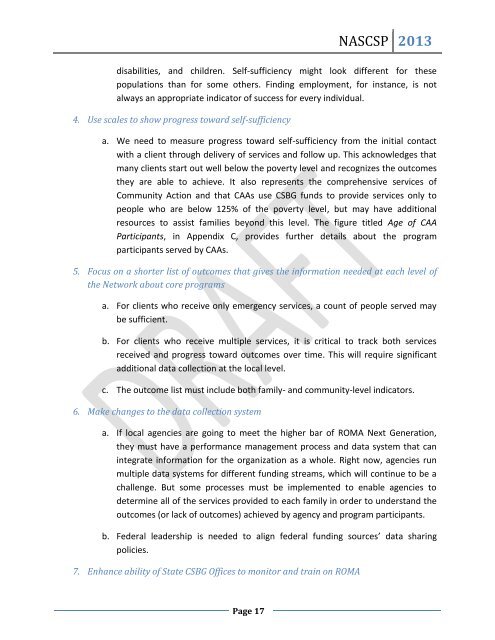white paper on performance management for community ... - FACA
white paper on performance management for community ... - FACA
white paper on performance management for community ... - FACA
You also want an ePaper? Increase the reach of your titles
YUMPU automatically turns print PDFs into web optimized ePapers that Google loves.
NASCSP 2013<br />
disabilities, and children. Self-sufficiency might look different <strong>for</strong> these<br />
populati<strong>on</strong>s than <strong>for</strong> some others. Finding employment, <strong>for</strong> instance, is not<br />
always an appropriate indicator of success <strong>for</strong> every individual.<br />
4. Use scales to show progress toward self-sufficiency<br />
a. We need to measure progress toward self-sufficiency from the initial c<strong>on</strong>tact<br />
with a client through delivery of services and follow up. This acknowledges that<br />
many clients start out well below the poverty level and recognizes the outcomes<br />
they are able to achieve. It also represents the comprehensive services of<br />
Community Acti<strong>on</strong> and that CAAs use CSBG funds to provide services <strong>on</strong>ly to<br />
people who are below 125% of the poverty level, but may have additi<strong>on</strong>al<br />
resources to assist families bey<strong>on</strong>d this level. The figure titled Age of CAA<br />
Participants, in Appendix C, provides further details about the program<br />
participants served by CAAs.<br />
5. Focus <strong>on</strong> a shorter list of outcomes that gives the in<strong>for</strong>mati<strong>on</strong> needed at each level of<br />
the Network about core programs<br />
a. For clients who receive <strong>on</strong>ly emergency services, a count of people served may<br />
be sufficient.<br />
b. For clients who receive multiple services, it is critical to track both services<br />
received and progress toward outcomes over time. This will require significant<br />
additi<strong>on</strong>al data collecti<strong>on</strong> at the local level.<br />
c. The outcome list must include both family- and <strong>community</strong>-level indicators.<br />
6. Make changes to the data collecti<strong>on</strong> system<br />
a. If local agencies are going to meet the higher bar of ROMA Next Generati<strong>on</strong>,<br />
they must have a <strong>per<strong>for</strong>mance</strong> <strong>management</strong> process and data system that can<br />
integrate in<strong>for</strong>mati<strong>on</strong> <strong>for</strong> the organizati<strong>on</strong> as a whole. Right now, agencies run<br />
multiple data systems <strong>for</strong> different funding streams, which will c<strong>on</strong>tinue to be a<br />
challenge. But some processes must be implemented to enable agencies to<br />
determine all of the services provided to each family in order to understand the<br />
outcomes (or lack of outcomes) achieved by agency and program participants.<br />
b. Federal leadership is needed to align federal funding sources’ data sharing<br />
policies.<br />
7. Enhance ability of State CSBG Offices to m<strong>on</strong>itor and train <strong>on</strong> ROMA<br />
Page 17









